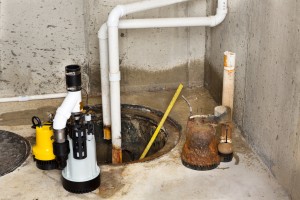Sump Pump
 If you’ve ever experienced water leakage in your basement you likely know the negative effects of excessive moisture firsthand, everything from destroyed property to moss and mold growth to pest infestation.
If you’ve ever experienced water leakage in your basement you likely know the negative effects of excessive moisture firsthand, everything from destroyed property to moss and mold growth to pest infestation.
Sump pumps are meant to negate these problems.
Installed beneath the basement floor, these devices pump excess water out of your basement, leaving you with minimal cleanup. If they’re allowed to work at their peak level of potential, they can be highly effective.
However, there are plenty of ways that sump pumps can go wrong, and if they are allowed to the effects can be quite inconvenient, if not severe.
Sump Pump Tips
- Avoid Overflow: Perhaps the most common sump pump issue experienced by homeowners is overflowing. Fortunately, it doesn’t happen all that often. A sump pump will generally only overflow if the pump itself ceases to function or if it is clogged with debris. Therefore, the best way to prevent this occurrence is to keep your sump as clean as possible. A little maintenance can go a long way. Also, if the pump does begin to overflow it is imperative to include a float switch or a sensor to shut the machine off once the water within reaches a certain level. A sump pump is dependent on two components to function: a pump and a drain. If the drain is clogged and the pump continues to run it will overflow. A float switch can prevent that from happening.
- Be Careful Where it Leads: If you want your sump pump to be truly effective it’ll need to have a daylight exit, a place for the water to go where it will no longer interfere with your property. Ideally, this will be something like a storm drain or a retention pond. Many people have a sump pump which simply dumps the excess water they contain back into the owner’s yard. Of course, where there’s excess water in your yard flooding can occur, and therefore your sump pump may become the instigator of an unfortunate cycle.
- Pick the Right Pipe: If something goes wrong with the pipe leading from your sump pump it will not be able to work effectively. In fact, it won’t really be able to work at all. Be sure to choose a non-corrugated pipe, and make sure it’s a Schedule 35 or better. The last thing you want is for your discharge pipe to freeze or be invaded by a tree root.
Get a Backup Battery: As we all know, excess moisture is often accompanied by storms. Unfortunately, heavy storms are in turn often accompanied by power outages, and if one occurs your pump may not be able to function and will overflow. That’s why it’s a good idea to get a backup battery to ensure that even if there’s a power outage your sump pump will continue to work effectively.
Twin Oaks Landscape can help with a custom drainage solution to meet your every need. Simply contact us to begin the process today.
Gallery
“We recommend Twin Oaks to any entity looking for a full-service, talented, and responsive provider.”
